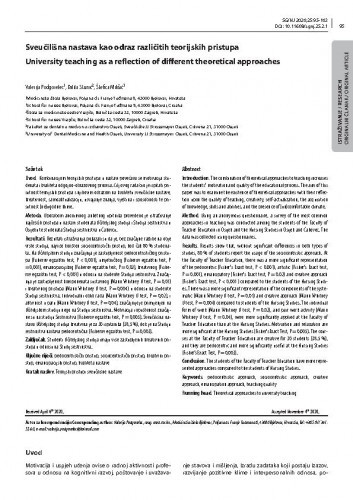Uvod: Kombinacijom teorijskih pristupa u nastavi povećava se motivacija stu- denata i kvaliteta odgojno-obrazovnog procesa. Cilj ovog rada bio je ispitati prisutnost teorijskih pristupa s njihovim odrazom na kvalitetu sveučilišne nastave, kreativnost, samoaktualizaciju, usvajanje znanja, vještina i sposobnosti te pri- sutnost (ne)ugodne klime. Metoda: Uporabom anonimnog anketnog upitnika provedeno je istraživanje najčešćih pristupa u nastavi studenata Učiteljskog studija i Studija sestrinstva u Osijeku te studenata Studija sestrinstva u Čakovcu. Rezultati: Rezultati istraživanja pokazali su da je, bez značajne razlike na obje vrste studija, najviše korišten sociocentristički pristup, kod čak 80 % studena- ta. Na Učiteljskom studiju značajnija je zastupljenost pedocentrističkog pristu- pa (Fisherov egzaktni test, P <0,001), umjetničkog (Fisherov egzaktni test, P = 0,001), emancipacijskog (Fisherov egzaktni test, P = 0,02), kreativnog (Fishe- rov egzaktni test, P <0,001) u odnosu na studente Studija sestrinstva. Značaj- nija je zastupljenost komponenata sustavnog (Mann Whitney U test, P = 0,01) i kreativnog pristupa (Mann Whitney U test, P = 0,004) u odnosu na studente Studija sestrinstva. Individualni oblik rada (Mann Whitney U test, P = 0,02), i aktivnost u paru (Mann Whitney U test, P = 0,04), značajnije je primijenjen na Učiteljskom studiju nego na Studiju sestrinstva. Motivacija i opuštenost značaj- ne su na studiju Sestrinstva (Fisherov egzaktni test, P = 0,005). Sveučilišna na- stava Učiteljskog studija kreativna je za 30 ispitanika (38,5 %), dok je na Studiju sestrinstva nastava pedocentrična (Fisherov egzaktni test, P = 0,003). Zaključak: Studenti Učiteljskog studija imaju više zastupljenih kreativnih pri- stupa u odnosu na Studij sestrinstva.; Introduction: The combination of theoretical approaches to teaching increases the students’ motivation and quality of the educational process. The aim of this paper was to examine the existence of theoretical approaches with their reflection upon the quality of teaching, creativity, self-actualization, the acquisition of knowledge, skills and abilities, and the presence of (un)comfortable climate. Method: Using an anonymous questionnaire, a survey of the most common approaches in teaching was conducted among the students of the Faculty of Teacher Education in Osijek and the Nursing Studies in Osijek and Čakovec. The data was collected using questionnaires. Results: Results show that, without significant differences in both types of studies, 80 % of students report the usage of the sociocentristic approach. At the Faculty of Teacher Education, there was a more significant representation of the pedocentric (Fisher’s Exact test, P <0.001), artistic (Fisher’s Exact test, P = 0.001), emancipatory (Fisher’s Exact test, P = 0.02) and creative approach (Fisher’s Exact test, P <0.001 ) compared to the students of the Nursing Studies. There was a more significant representation of the components of the systematic (Mann Whitney U test, P = 0.01) and creative approach (Mann Whitney U test, P = 0.004) compared to students of the Nursing Studies. The individual form of work (Mann Whitney U test, P = 0.02), and pair work activity (Mann Whitney U test, P = 0.04), were more significantly applied at the Faculty of Teacher Education than at the Nursing Studies. Motivation and relaxation are more significant at the Nursing Studies (Fisher’sExact Test, P = 0.005). The courses at the Faculty of Teacher Education are creative for 30 students (38.5 %), and they are pedocentric and more significantly useful at the Nursing Studies (Fisher’sExact Test, P = 0.003).
Sažetak

